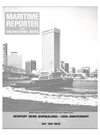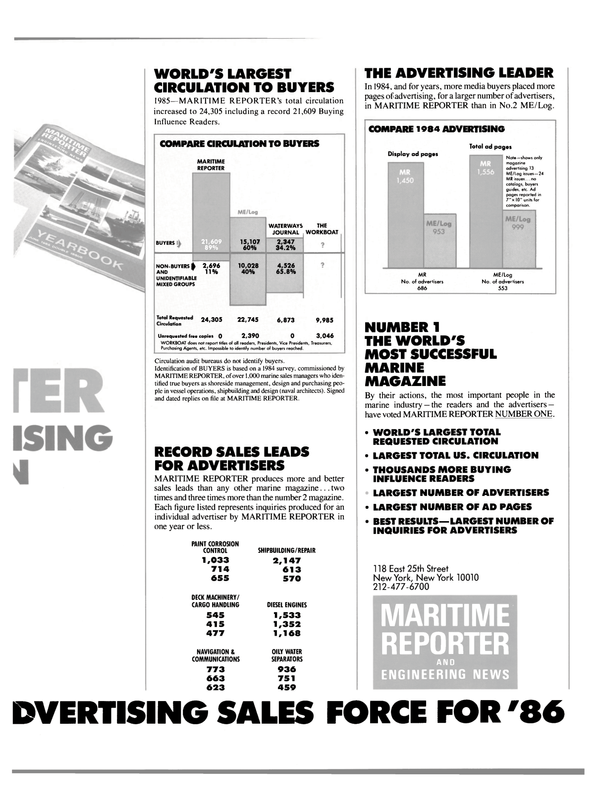
Russellstoll Engineers Gain Patent For Fluorescent Lamp-Locking Device
Richard Havens, Joseph Flor, and Peter Panayoti have received a U.S. patent for a selfactuating locking assembly to prevent undesired rotation and fluorescent lamp "fall-out" problems resulting from the vibration conditions typical of marine and industrial environments. The patent has been assigned to the Russellstoll Division, Midland-Ross Corporation.
The locking assembly is attached to a conventional fluorescent tube socket and is designed to prevent the rotation and subsequent fall-out of a standard, straight-line type fluorescent lamp even under the vibration and impact conditions encountered aboard ship or in industrial plants.
The invention consists of a Cshaped spring that holds two nonconductive locking members between the arms of the C and attaches to a conventional socket. The locking members permit the pins of the fluorescent lamp to be inserted into the socket as usual, but then automatically lock the pins into position.
The lamp is easily removed, however, by spreading the C slightly with the fingers while rotating the lamp.
Presently included in low-profile ceiling lights intended primarily for marine or industrial use, the Russellstoll locking device can be incorporated into most existing fluorescent fixtures. Only one end of the lamp need be locked to prevent rotation.
The self-locking assembly is initially being applied to Russellstoll's SnapLight marine and industrial fixture line on fixtures holding 4- foot lamps. Shorter lamps are not usually loosened by vibration.
For additional information on the new locking device, Circle 33 on Reader Service Card
Read Russellstoll Engineers Gain Patent For Fluorescent Lamp-Locking Device in Pdf, Flash or Html5 edition of May 1986 Maritime Reporter
Other stories from May 1986 issue
Content
- Texaco Signs Globtik Ship Management Contract page: 5
- National AirOil Introduces Portable Burner Ignitor page: 5
- Hitachi Zosen Delivers High-Speed Containership To Highness Maritime page: 6
- Moss Point Marine Lays Keel For First Of Two Navy Landing Craft page: 6
- Haggett Chairman Of Shipbuilders Council— Schaefer Is Vice Chairman page: 7
- SNAME SPRING MEETING/ STAR SYMPOSIUM page: 8
- Hyundai Launches Advanced Aker Semisubmersible Drilling Rig page: 11
- Radio-Holland To Distribute Anschuetz Products In U . S. page: 14
- John Crane Schedules 'Mechanical Maintenance S k i l l s ' Seminar Programs page: 15
- Bailey Supplies Control System For World's Largest Submersible Derrick Barge page: 16
- PSMA Elects Board Of Directors For 1986 page: 18
- Moran Towing Appoints Kenneth S. Johnson Chief Harbor Dispatcher page: 18
- Taylor Diving Receives Contracts From Shell, Mobil page: 19
- 2-Volume Research Report Now Available On Fuel Efficient Vessel Operations page: 19
- Grandi Motori To Unveil Diesel Engine Designs page: 20
- Bailey Offers Technical Paper On Better Combustion Control page: 20
- Navy Acquisition Streamlining Topic At Hampton Roads SNAME page: 22
- Adams & Porter Elects Three New Executives page: 22
- IMA To Publish Report On Navy Ship Systems Market page: 22
- Racal Marine Moves To New Headquarters In Cranford, N.J. page: 23
- New McAllister Tractor Tug Inaugurates Jacksonville Service page: 24
- Alaska Barge Lines Begins New Service page: 26
- Coast Guard Admiral Urges More Input From The Marine Community page: 26
- Imperial Receives Order For 500 Survival Suits page: 27
- Todd Chairman To Retire In July; Board Nominates New Chairman And President page: 28
- Free Literature Offered On New NABRICO Hand Winch page: 28
- NEWPORT NEWS MARKS 100 YEARS OF SHIPBUILDING LEADERSHIP page: 29
- CDI Offshore Appoints Payne And Domingue To Management Positions page: 37
- BFGoodrich Offers Brochure On Cutless Line Of Rubber Bearings page: 37
- POSIDONIA '86 INTERNATIONAL SHIPPING EXHIBITION page: 38
- S h i p b u i l d i n g And Ocean Engineering Conference In H e l s i n k i — S e p t . 7 - 10 page: 41
- Bardex Receives Contract For Rig Skidding S y s t em F r om Shell U . K. page: 41
- Centrico Manufactures High-Tech Centrifuges page: 41
- A Report On The Yugoslav Shipbuilding Industry page: 42
- Unique Slipway Launch Of Aft Part Of Hull Performed At 3.Maj Yard page: 42
- 2-Volume Research Report, 'Ship Performance Analysis System' Now Available page: 43
- Baker Named President Of WATERCOM page: 44
- Sperry To Market Puroflow Power-Line Filters page: 45
- New Racal Survey And Dredge Control System page: 48
- GALAX Offers New Free Literature On Kit-Assembled Marine Control Consoles page: 48
- Russellstoll Engineers Gain Patent For Fluorescent Lamp-Locking Device page: 49
- Cummins-Powered Empress Launched By Serodino, Inc. page: 49
- Hardware Specialty Offers Complete Shipbuilding Fastener And Hardware Line page: 52
- Full-Color Brochure On 150-Ton Mobile Boat Hoist From Marine Travelift page: 52
- Sail Freight International Offers Design For Auxiliary Wind Propulsion page: 52
- New Simulator Training Complex For U.S. Navy page: 53
- CCA Holds Meeting, Appoints Officers page: 53
- Omnithrusters installed In Variety Of Canadian Government Vessel Types page: 59
- Valmet Opens New Engineering Office In Calgary, Canada page: 59
- Woodward Offers Brochures On Turbine Modernization And Cogeneration Process page: 59
- EG&G Receives New 3-Year Navy Contract For Program Support page: 59
- NABRICO Constructs 2 Dump Scows For Panama Canal Commission page: 63
- Tri-Tex Introduces New Video Medcare First Responder® System page: 63
- J.J. Henry Announces Key Executive Appointments page: 63


